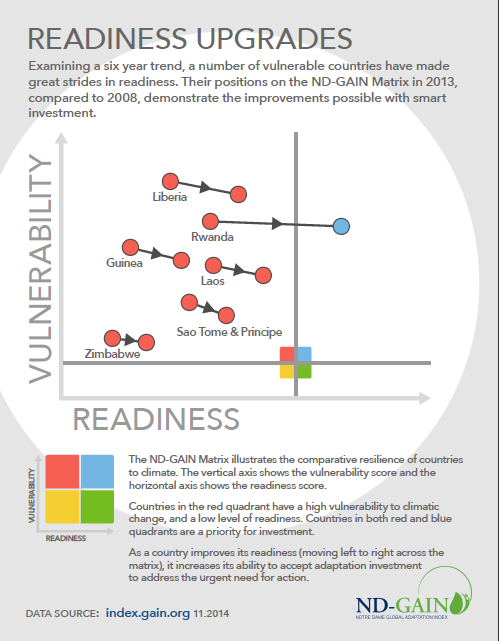Adaptation Potential: Africa's Hope and Promise
Adaptation Potential: Africa’s Hope and Promise Hope for building communities resilient to climate change around the world emerges from the unlikeliest of places—Africa. Shortly after release of the ND-GAIN 2014 Index, the Dr. Martin Luther King, Jr. Visiting Professor at the Department of Urban Studies and Planning at MIT, Calestous Juma, maintained that rankings alone fail to account for novel technological opportunities that communities not yet locked into conventional frameworks may readily adopt.
Focusing only on the rankings, Juma added in a CNN opinion editorial, risks sowing “despair among the poor and complacency among the rich.” He believes that developing countries have much cause for hope and that we must not ignore a poor nation’s creativity in the fight against climate change.
As evidence of Africa’s potential for generating responses to issues unique in our time, Juma cited the successful Sahalian drought response borne out of local collaboration as well as the mobile money-transfer initiative in Kenya. Most striking is the work of women engineers in controlling traffic through the use of robot technology in the CRD, a country ranked 5th from rock bottom of 178 countries on the ND-GAIN Index.
This hope and promise are reflected in ND-GAIN’s Readiness Matrix. Nestled in Africa are many of the world’s most vulnerable and least-prepared countries, but they each have made substantial progress in readiness to accept adaptation investment. These countries include Guinea, Laos, Liberia, Sao Tome & Principe, Zimbabwe and, most remarkably, Rwanda, which --has progressed entirely out of the red zone. The message is clear: the time is ripe for adaptation investment. In the coming years, African countries likely will emerge as leaders in the climate adaptation scene as investment continues to grow.
In particular, alternative energy holds much promise in Africa. Although many parts of the continent receive abundant insolation – the amount of solar radiation energy received on a given surface area during a given time – and constant winds, alternative energy investment and development still are in their infancy. Limited information access and poor local training further hinder technological leaps, contends Juma.
Collaborations between foreign and local agencies can bridge this gap. For instance, ND-GAIN, the Notre Dame Initiative for Global Development (NDIGD) and the Universidade Católica de Moçambique (UCM) teamed up to assess the impacts of early-warning systems for climate-related disasters in Mozambique. They evaluated the impacts of Community-based Disaster Management Committees (CLGRCs) and early-warning systems to show what and how interventions lead to increased climate resilience.
Moving forward, it is crucial that we understand the extent of Africa’s adaptation potential and also facilitate its adaptation efforts. Africa likely will hold solutions to the 21st century’s most pressing problems.
Blog compiled with help from Sophia Chau, Intern, ND-GAIN

